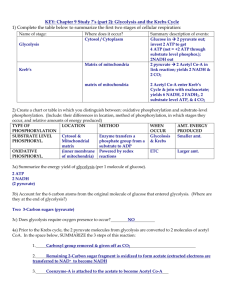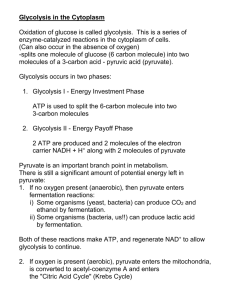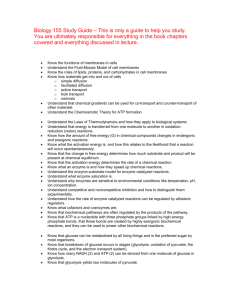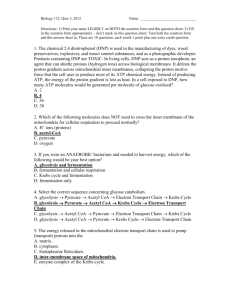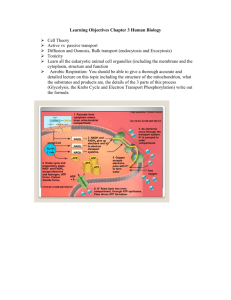Cell Respiration Quick Hitter Questions
advertisement
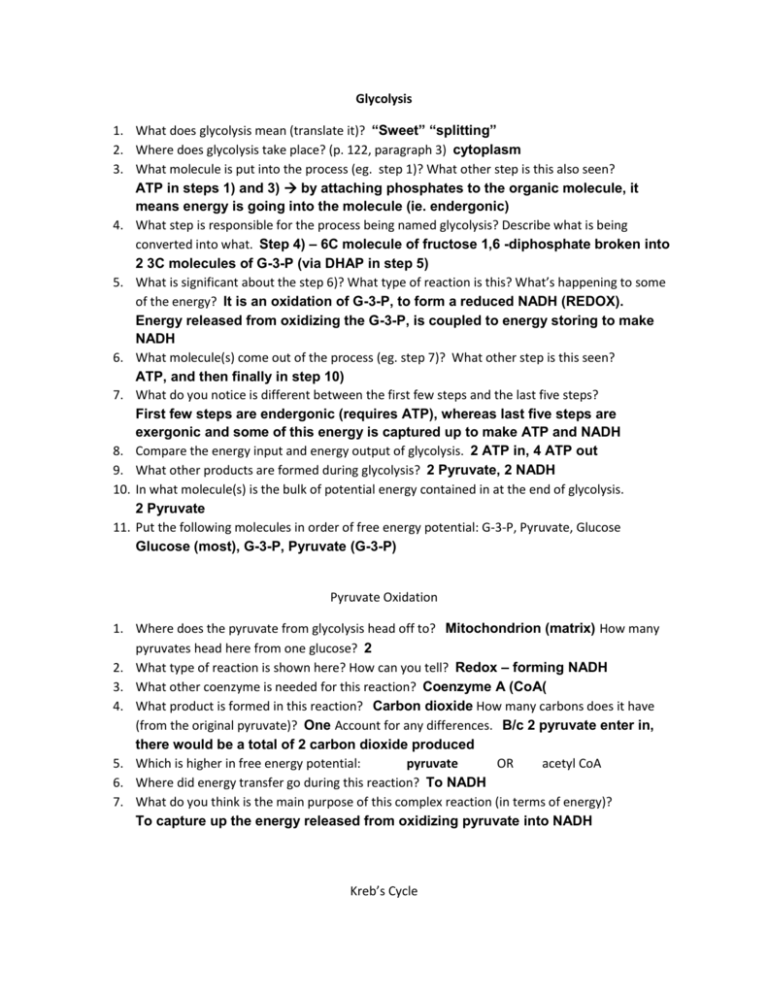
Glycolysis 1. What does glycolysis mean (translate it)? “Sweet” “splitting” 2. Where does glycolysis take place? (p. 122, paragraph 3) cytoplasm 3. What molecule is put into the process (eg. step 1)? What other step is this also seen? ATP in steps 1) and 3) by attaching phosphates to the organic molecule, it means energy is going into the molecule (ie. endergonic) 4. What step is responsible for the process being named glycolysis? Describe what is being converted into what. Step 4) – 6C molecule of fructose 1,6 -diphosphate broken into 2 3C molecules of G-3-P (via DHAP in step 5) 5. What is significant about the step 6)? What type of reaction is this? What’s happening to some of the energy? It is an oxidation of G-3-P, to form a reduced NADH (REDOX). Energy released from oxidizing the G-3-P, is coupled to energy storing to make NADH 6. What molecule(s) come out of the process (eg. step 7)? What other step is this seen? ATP, and then finally in step 10) 7. What do you notice is different between the first few steps and the last five steps? First few steps are endergonic (requires ATP), whereas last five steps are exergonic and some of this energy is captured up to make ATP and NADH 8. Compare the energy input and energy output of glycolysis. 2 ATP in, 4 ATP out 9. What other products are formed during glycolysis? 2 Pyruvate, 2 NADH 10. In what molecule(s) is the bulk of potential energy contained in at the end of glycolysis. 2 Pyruvate 11. Put the following molecules in order of free energy potential: G-3-P, Pyruvate, Glucose Glucose (most), G-3-P, Pyruvate (G-3-P) Pyruvate Oxidation 1. Where does the pyruvate from glycolysis head off to? Mitochondrion (matrix) How many pyruvates head here from one glucose? 2 2. What type of reaction is shown here? How can you tell? Redox – forming NADH 3. What other coenzyme is needed for this reaction? Coenzyme A (CoA( 4. What product is formed in this reaction? Carbon dioxide How many carbons does it have (from the original pyruvate)? One Account for any differences. B/c 2 pyruvate enter in, there would be a total of 2 carbon dioxide produced 5. Which is higher in free energy potential: pyruvate OR acetyl CoA 6. Where did energy transfer go during this reaction? To NADH 7. What do you think is the main purpose of this complex reaction (in terms of energy)? To capture up the energy released from oxidizing pyruvate into NADH Kreb’s Cycle 1. What molecule is put into Kreb’s Cycle? Acetyl CoA Where did this molecule come from? From pyruvate oxidation 2. What happens in the first step of Kreb’s Cycle? Oxaloacetate combines with Acetyl CoA to form citrate 3. What waste products are given off during the Kreb’s Cycle? Carbon dioxide (4 in total) 4. How many of these molecules (from Q # 3) have been given off so far in cellular respiration? 2 from pyruvate oxidation 5. How many NAD+ molecules are reduced to NADH during Kreb’s Cycle? 6 total (Each turn of the Kreb’s cycle makes 3 – b/c 2 cycles take place, it equals 6 6. Are there any other energy carrier molecules produced in Kreb’s Cycle? FADH Is yes, what are they? 7. By what method is ATP produced in Kreb’s Cycle? Substrate-level phosphorylation 8. What do you think is the main purpose of the Kreb’s cycle reactions (in terms of energy)? HINT: What was the main event that repeated itself? Oxidation-reduction; Look at all the steps producing NADH and FADH – this means some of the energy released from oxidizing off carboxyls (to make carbon dioxide) from the original glucose is being transferred to make reduced coenzyme carriers Electron Transport Chain & Oxidative Phosphorylation 1. How many ATP (via substrate-level phosphorylation) have been produced thus far (ie. in the previous stages)? A NET OF FOUR HAS BEEN PRODUCED 2. Where is most of the “trapped” energy located? Coenzymes, NADH and FADH 3. What is the electron transport chain? A series of protein complexes in the inner mitochondrial membrane that act to transfer electrons (accept and donate electrons), and in the process contribute to ATP production via oxidative phosphorylation 4. Examine Figure 3.12 and read the last paragraph of p. 128 (continue reading to p. 129). What do coenzyme electron energy carriers (NADH, FADH2) do with their electrons? Donate them to protein complexes within the inner mitochondrial membrane (eg. NADH donates to NADH dehydrogenase, FADH donates to Q… or complex II using the diagram from class) 5. What is the energy released from this electron transfer “coupled” to? Energy released is coupled to the pumping of protons from the matrix to the IMS 6. We have shown that the FADH2 “trucks” do not transport as much energy? Why is this? B/c they bypass the first protein complex, instead feeding their electrons in at Q (or complex II) using the diagram from class) 7. What is the final electron acceptor of the ETC? Describe the event that takes place. Oxygen. It accepts 2 electrons, becomes reduced, and then it attracts 2 H+ to make water Read p. 129 under the subheading Chemiosmosis 8. What has happened to some of the energy originally contained in NADH and FADH2? It has been used to create an electrochemical gradient 9. Is this “energy” now in the form of potential or kinetic energy? Explain. Potential energy. There is a chemical and charge separation between the IMS and the matrix. This is equivalent to stored energy potential. (eg. like a battery, or like water at the top of a dam) 10. What now happens to the hydrogen ions? Where do they go? In what form will the energy be in now? (answer not in text… THINK: “movement energy”) The hydrogen ions can only diffuse through the ATP synthase channel. By moving through, they will enter back into the matrix, attempting to equalize their gradient. Because they are moving, the energy would now be kinetic. 11. How does this energy get captured up by ATP synthase? ATP synthase harnesses the energy of H+ movement by bonding phosphate to ADP to make ATP 12. What molecule would be pivotal for allowing this process to occur over… and over… and over again? (NOT in textbook) HINT: Study picture Figure 3.12, Part A Oxygen. If it was not present to “ferry” away electrons, a backlog would occur. The last electron acceptor (cytochrome oxidase) would not have anywhere to donate electrons. This means C couldn’t transfer to cytochrome oxidase… this means cytochrome b/c1 couldn’t transfer to C… in other words, everything “grinds” to a halt. With nothing going on, no H+ can be pumped, no gradient formed, and thus no ATP made
